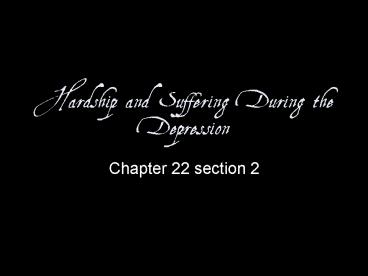Hardship and Suffering During the Depression PowerPoint PPT Presentation
1 / 13
Title: Hardship and Suffering During the Depression
1
Hardship and Suffering During the Depression
- Chapter 22 section 2
2
Main Idea and Key Terms
- During the Great Depression Americans did what
they had to do to survive
- Shantytown
- Soup Kitchen
- Bread line
- Dust Bowl
- Direct relief
3
Devastation
- Statistics such as the unemployment rate tell
only part of the story - The Depression brought hardship, homelessness,
and hunger to millions
4
The City
- In cities, people lost their jobs, were evicted,
and ended up in the streets - Some slept in parks or sewer pipes, using
newspapers as blankets - Numerous Shantytowns sprang up
- Every day the poor dug through garbage cans or
begged
5
- Soup kitchens offered free or low-cost food
- Bread lines were lines of people waiting to
receive food provided by charitable organizations
or public agencies became common - Conditions for African Americans and Latinos were
worse
6
- African Americans and Latinos were being paid
less, and suffering violence from whites
competing for the same jobs - 24 African Americans were lynched in 1933
- People in the Southwest demanded that Latinos be
deported, even though some had been born in the
U.S.
7
Warning!!!
- The following photo(s) are graphic in nature
- Please look away or step into the hall if you do
not want to see them.
8
Rural America
- Life in rural areas was hard, but had one
advantage they could grow food - With falling prices and rising debt, thousands
lost their land - Between 1929-1932, 400,000 farms were foreclosed
on
9
The Dust Bowl
- A drought began in the early 1930s
- Over farming and the clearing of land combined
with the drought allowed wind to scatter topsoil - The region hardest hit, including parts of
Kansas, Oklahoma, Texas, New Mexico, and Colorado
came to be known as the dust bowl - By the end of the 30s, thousands had migrated
west
10
Effects on Family
- Americans believed in traditional values and
family unity - Played games at home
- Listened to the radio
- Many men broke under the strain, abandoning their
families, and became hoboes - No direct relief existed (govt. payments of food
or money)
11
- Women began to can food and sew clothes
- Women began to work out of the home more
- They became targets of resentment
- Many believed they had no right to work while men
were unemployed
12
- Children had poor diets and health care
- There was a rise in malnutrition and diet related
diseases like rickets - The school year was shortened, and children went
to work - Teens would ride railroads
- Many were beaten or killed
- 1929-39 K 24,647 I 27,171
13
Social and Psychological Effects
- People lost the will to survive
- Suicide rates rose 30
- 3X as many people checked into mental hospitals
- Adults stopped going to the doctor or dentist
- Put off college, marriage, and children
- People showed great kindness as well

